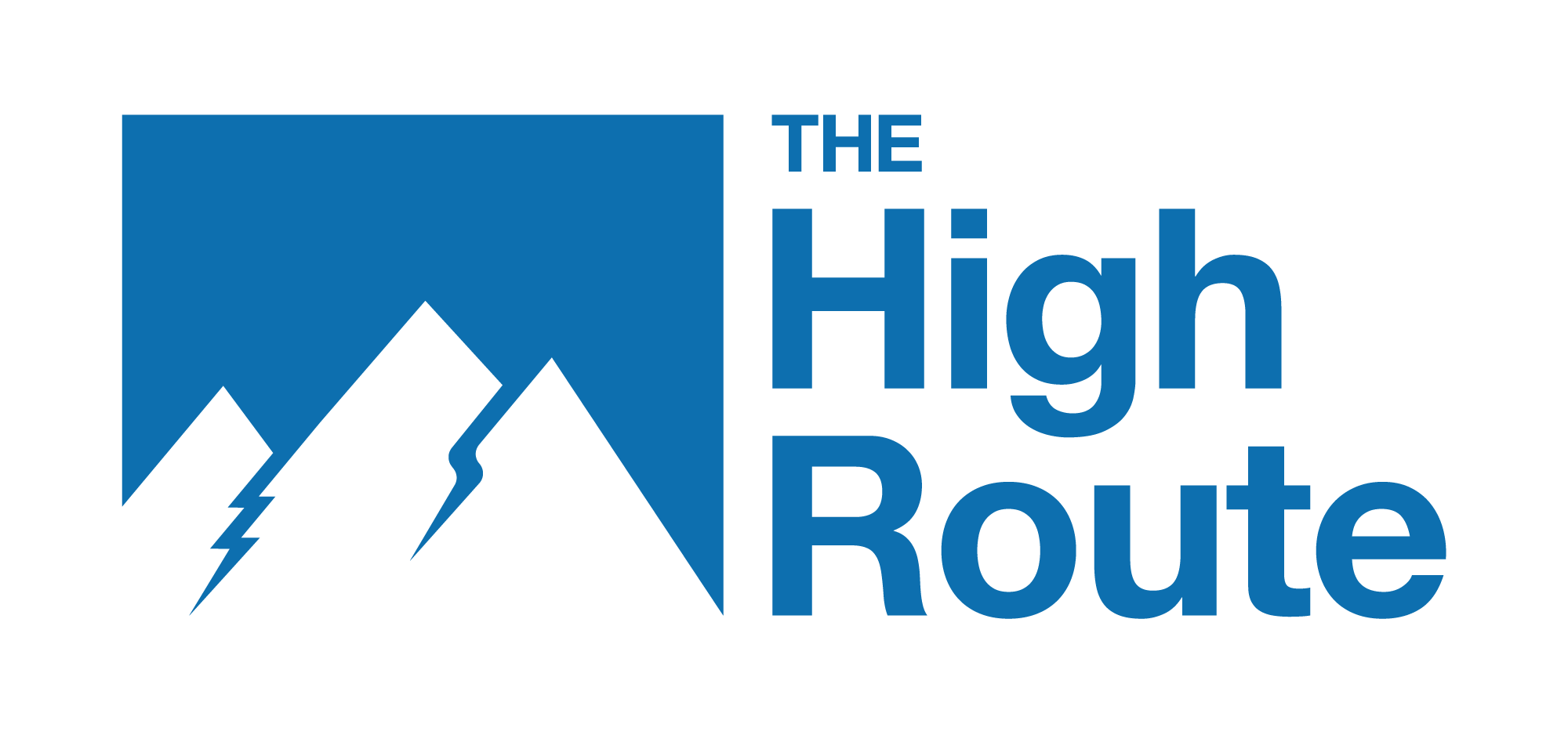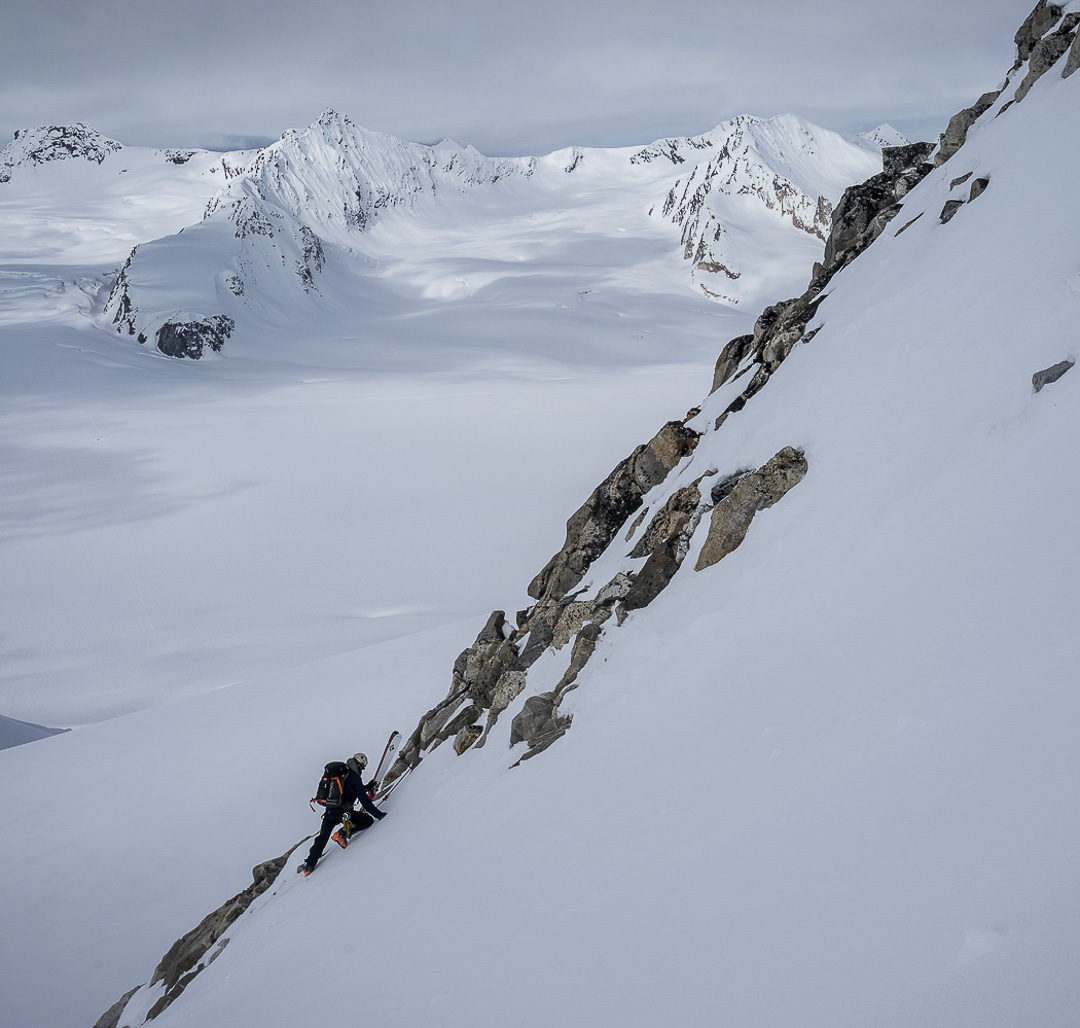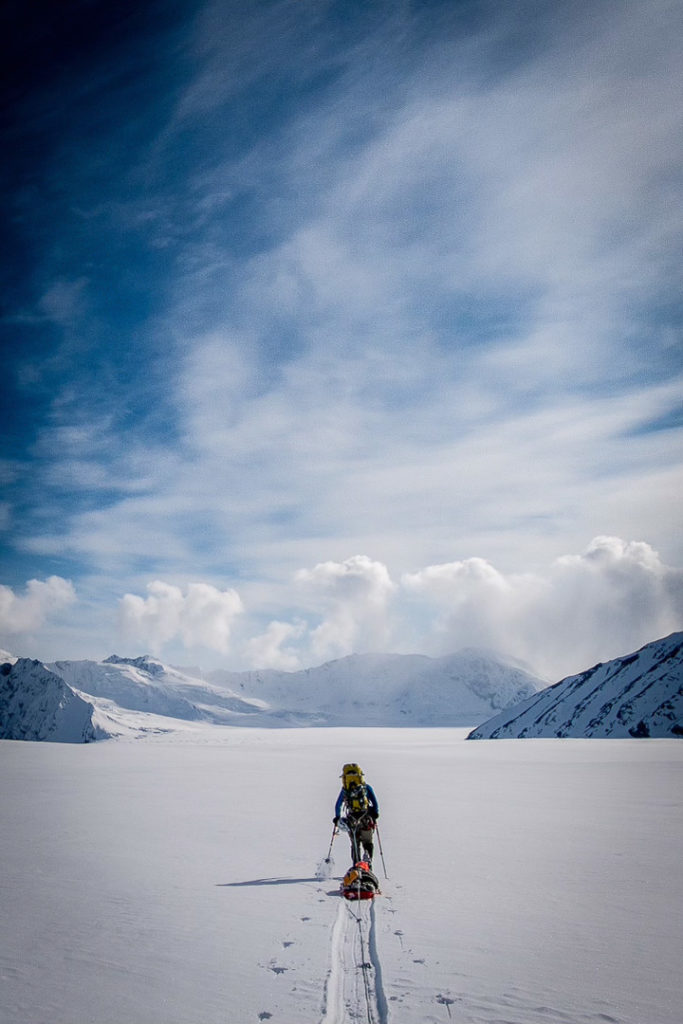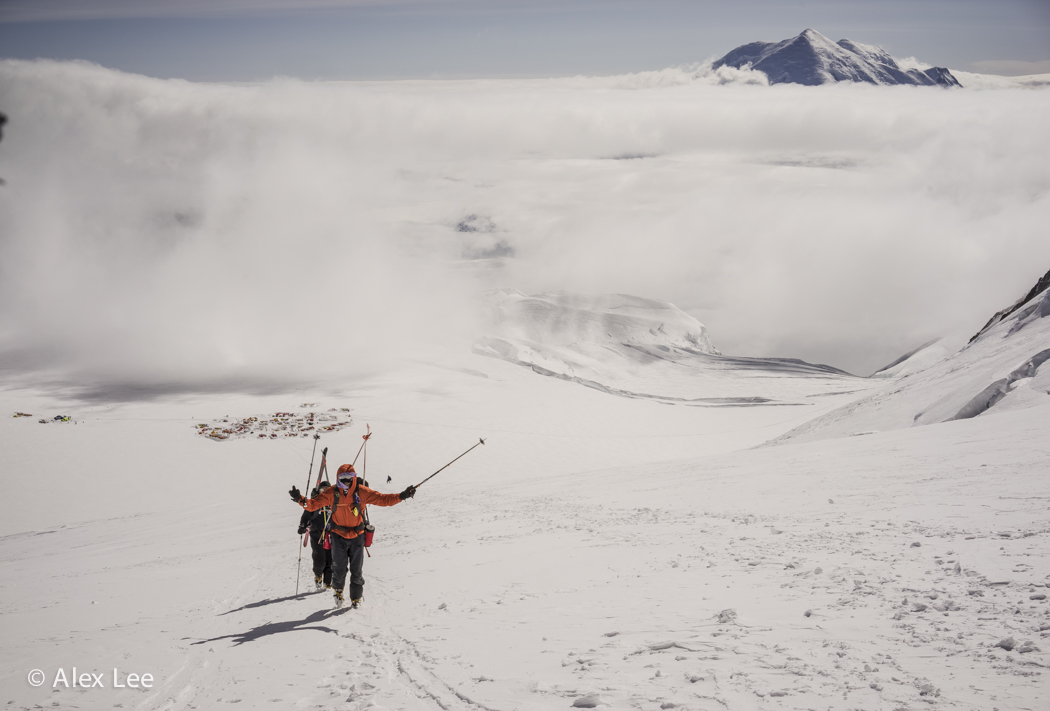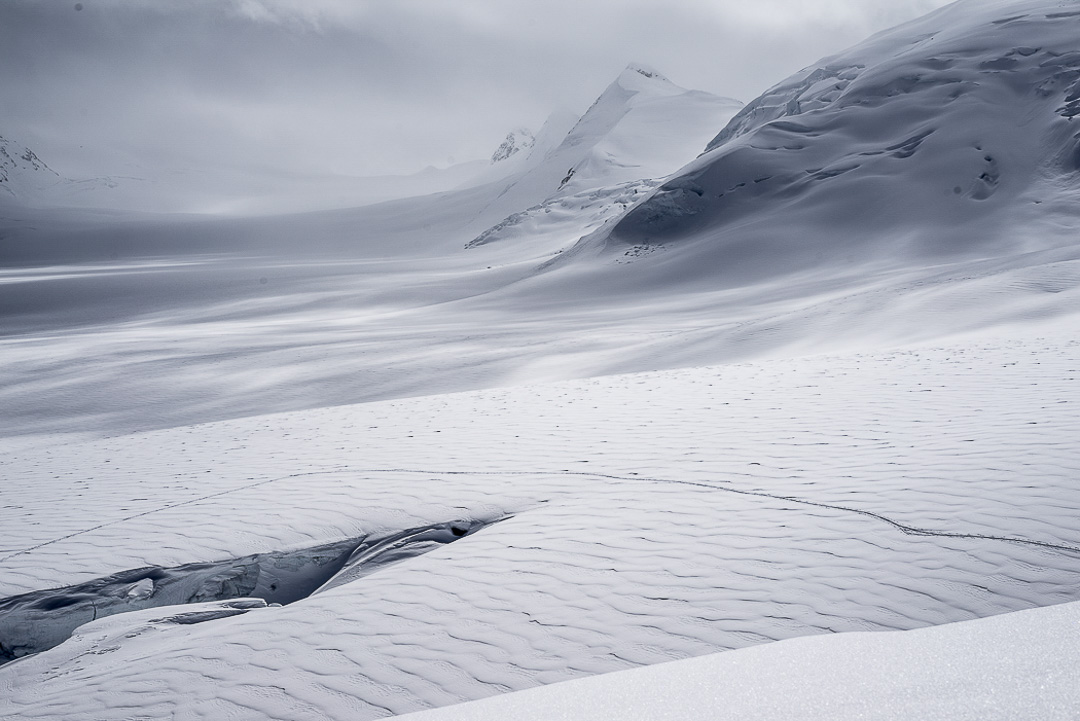
Looking down the main fork of the Kahiltna towards Sultana (Mt. Foraker) and Begguya (Mt. Hunter). Photo: Alex Lee
The High Route connects with Denali National Park’s South District Ranger, Tucker Chenoweth, to discuss ski mountaineering and general travel on the mountain.
The COVID-19 pandemic is in the not-so-deep recesses of our collective minds. Life shut down. Some mountains, mainly those requiring permits, were also part of the shutdown. Denali and the surrounding mountainscape were closed to permitted climbs for the 2020 season. When the climbing scene rebooted in the Central Alaska Range in spring 2021, a May 27th Denali Dispatch authored by the Denali Mountaineering Rangers caught my eye. The dispatch title was attention-grabbing: “Troubling Trends.”
Like any other magnet for humanity, Denali can be prone to our collective and individual failings. Here are some of the trends highlighted in the dispatch. However, we encourage you to read the dispatch in full.
- “We have seen a disturbing amount of overconfidence paired with inexperience in the Alaska Range.”
- “Another disturbing trend we are seeing is people attempting the summit from 14,000 feet.”
- Related to the above dynamic (a single push summit day from 14k), the dispatch states the dissolution and formation of new teams is a troubling trend.
- Of interest to skiers, the dispatch states, “We have also seen an increase of skiers aspiring for highly coveted lines off the summit such as the Messner. High elevation peaks in the Alaska Range are often wind-scoured with low snowpack, making for highly challenging, unforgiving ski conditions. Even the most experienced skiers in Lower 48 terrain get in over their heads in the Alaska Range, and conditions can change rapidly from the top to the bottom of a 5,000-foot ski run. Conditions need to be perfect for skiers to pull this off safely.”
Here’s the point: when Denali National Park’s permitted climbing season resurrected in 2021, there was likely some pent-up summit and ski descent fever.
Here we are, on the cusp of the 2024 Denali climbing/ski season (some folks are already in the range). Last month, we spoke with Tucker Chenoweth, the South District Ranger for Denali National Park. As part of his responsibilities, Chenoweth oversees the mountaineering rangers who regularly patrol Denali from 7k and beyond. Our discussion is lightly edited for clarity and geared more toward those seeking to ski/ride objectives on Denali and some other locations in the broader range.
***
The High Route: For context, how long have you worked at Denali National Park?
Tucker Chenoweth: I started up here as a volunteer in 2001 and then got hired in 2006. So, I’ve been with the mountaineering ranger program that long. And now, this is six years as the District Ranger. I’m now in charge of the mountaineering program and the search and rescue aspects here in the Alaska range.
THR: Let’s dig deeper into the job specifics. How would you describe your job with the National Park Service?
Chenoweth: I’m the South District Ranger for visitor resource protection. I basically supervise search and rescue, EMS or emergency services, and resource protection falls under me for the South District of the park. The South District includes all the mountainous terrain in the park, so the Kichatnas all the way up through the Eldridge. The big part of it is the Denali climbing season. That’s where most of our energy goes. I manage the climbing program, which includes the Talkeetna Ranger Station and the mountaineering rangers.
THR: How many climbing rangers are on staff during the peak climbing season?
Chenoweth: There are 10 of us —give or take—and that’s the staffing model.
THR: At this point, are any rangers dedicated to a specific ski mountaineering patrol?
Chenoweth: No. Skis have always been part of the program as a travel mode, especially with the big glaciers on the approach. So skiing has always been a component of patrols. I’d say the ranger staff, in general, has become more adept at skiing in the last 15 years—for many, it was an expedition snowshoe mountain before then. We’ve adapted just as the user group has.
We have pretty strict guidelines on where and what we ski. For example, we wouldn’t send anybody to ski the Messner or anything like that. Travel by ski is really an acclimatization tool and a travel component for us. Many rangers these days are ski patrollers or ski guides; they definitely have that skill set. But our mission is a little different.
THR: You noted you have been in the ranger program since 2001 and in a supervisor role for the climbing rangers for six years. From your perspective, how has your job changed as it relates to the growth of ski mountaineering, the general increase in the number of skiers, and the objectives they may or may not be attempting to ski?
Chenoweth: There were several big changes at that time. I’ve seen the transition to the prevalent use of social media. This use came in conjunction with satellite communication capabilities, like with an InReach. We’ve seen this across the board, both with climbers and skiers.
Importantly, the use of InReach type devices changed search and rescue—it’s taken the search out of the rescue. We used to do a lot more searches. The climbing rangers sometimes didn’t know about accidents until weeks after because there were no immediate comms. But now, most folks are communicate daily with somebody in the outside world through satellite communication.
Maybe it’s a SOS, or maybe the climber checks in every day with a friend at a specific time, and they haven’t checked in in two days. But, through the device, the climber has a last known point. That’s a big change.
However, when we look specifically at skiing and ski mountaineering, the technology or gear has changed, too. Years ago, tele skis were the ski mountaineering setup because you could go further on that gear before the AT revolution. So, a limited number of people were willing to make a trip of this magnitude, like, say, a Denali trip, on that gear.
You’ll see the occasional person holding on to their tele skis, but we mostly see AT stuff as it has revolutionized the ease of mobility and distance people can go. With that gear evolution, we’ve seen a lot more people using skis on Denali, at least for the approach section up to 11 camp. It makes sense.
An interesting pivot was when Chris Davenport and crew came for a month basing out of the 14 K basin. From my recollection, they were the first ones to focus on skiing and opening up terrain. They opened it up in terms of skiing things that hadn’t been skied in the West Buttress area. That also coincided with the social media aspects—they were able to get that information out. And I think that that was a really notable shift.
People, all of a sudden, were like, “Oh, Denali is a ski mountain. It’s not just a climbing mountain.” I’m just speaking about Denali. But we’ve seen that shift.
The guiding companies are also dabbling in guided ski trips. The concessions or guiding companies used to be unable to ski guide on the mountain. This was due to restrictions on clients having to be roped all the time.
THR: Can you clarify that roped-up policy for a moment? That’s one of my questions.
Chenoweth: The roped-up policy was an interpretation of the old language in the contracts—it was based on the traditional style of guiding, which was no skis. Some guide companies were using skis occasionally on the lower glacier, where they could always maintain that roped policy.
Some companies were pushing a bit to open it up for ski mountaineering. So we took a hard look at the contracts, and we were able to make some ski mountaineering specific criteria that then allowed for unroped travel for the first time. So that’s evolved slowly, and it isn’t super popular because it’s a high-risk endeavor, in many ways, compared to roped-up travel. For now, only a few companies are willing to take on that risk.
It hasn’t been a super popular thing to do. But at least now, there’s an option if the right guide and company have the right client. I think most of the guided ski trips have been guided by guides who have worked with a specific client for many years, and they are very confident in that client’s ability—they work well together.
THR: I’m curious, as skiing, and specifically ski mountaineering has increased on the mountain, are there now skier specific needs that need to be addressed?
Chenoweth: Here at Denali, we have a significant advantage in messaging specifically to climbers and skiers because they have a mandatory briefing with a climbing ranger if they attempt Denali or Sultana (Foraker). At that time, we’ll address the trip’s objectives and their travel method. When we address a ski trip, we key in on a few things.
It’s always a group dynamic thing for every group—and so we address those complexities. We also highly encourage skiers to ascend the route they’re going to ski on Denali.
When you’re on the West Buttress mid-season, you’re following a trail. And some get into that mentality of groupthink, where everybody’s sharing information at camp, there’s different groups doing different things, moving different ways. And so I think it’s tempting just to take the easy route, which is the traditional route, and then drop into these bigger objectives—because it’s easier.
Where we’ve seen fatalities on the mountain, or serious injuries, is people not really knowing what the conditions are on the route they’re going to ski. On Denali, the West Buttress main route isn’t really representative of the top of the Orient, the top of the Messner, or the summit ridge, for that matter. I think people can get caught off guard thinking it’s a little bit more like névé or hard pack. The slope you’re skiing can quickly turn into a sheet of blue ice. And maybe there’s just an inch or two of new snow over it, so it looks good, but, in reality it’s highly variable conditions.
So that’s a big one: climb what you’re going to ski so you know firsthand what the conditions are, where you will group up, transition, and how that will all look on the descent.
THR: I think the literature and communications put out by the climbing rangers documents the unique conditions and dynamics on Denali. In other words, ski mountaineering in the lower 48 isn’t exactly analogous to skiing in the Alaska Range, and certainly, it is dissimilar to Denali, with such a massive range in elevations—from roughly 7k to 20k.
In the climbing rangers’ communication to the public in 2021, you tell skiers that conditions must be “perfect.”
“Perfect,” can be hard to come by. I imagine you have these skiers who have invested a ton of time and money into this specific goal, and climbing rangers are interfacing with some groups with a myopic view of success. Maybe climbing rangers have to play amateur psychologist on occasion, but how does your crew express to someone that the mountains are not going anywhere, and if it’s not “perfect,” it’ll be there in the following year? How does that conversation go?
Chenoweth: There’s that front-loading from the ranger here in Talkeetna, but we’re also moving on the mountain during a ranger patrol. The patrols are 25 days, give or take. During that time, the ranger crew often sees and interacts with groups and individuals at different points on the route.
The big difference is that rangers stay at 14-camp a little longer than most other camps. So we get two cycles per patrol to possibly contact or interface with groups. Further, the rangers watch and observe to learn who is out and about on the mountain. We note how teams function with their winter camping skills and how much they use the rope.
We also want skiers to understand that skiing, ascending and descending, is different with a heavy pack. And then they should consider what it is like skiing with the assurance of the rope in certain areas where crevasse falls are possible. What we really try to get people to do is understand that that rope is important. And it’s important to know how to manage it and how to ski together roped up; that’s a really difficult thing.
The more you practice it, the better you are at it, the easier it is to pull it out when needed. But if you’ve never practiced with it, that is really it; people just leave it in their pack because it’s easier not to do that.
But if you’re good at deploying the rope and treating it like any other climbing technique, it becomes part of the craft. And if your communication with your other ski mates is good, then you can use the rope effectively in the areas that you need to.
Circling back to your original question, we encourage folks to use that lower glacier area well before their big objective is in sight to work out the kinks. Use the rope down there. Get good at it. Become accustomed to skiing with a heavy pack. Know what that’s like.
Another big skill for skiers is addressing grouping up spots and awareness of crevasses, and knowing the general areas of concern so the party is not grouping up together unroped—a lot of times, the flat spot where a party groups up is the snow bridge. Anytime we travel in the mountains, it can be the little things we aren’t aware of that pose the greatest risks.
As climbing rangers, we’re not going to turn anybody around, and we’re not going to make a party feel incompetent. Our goal is to talk with a group and raise awareness, see where the gaps are, and try to offer a suggestion.
We might say, “You should climb up that, we know conditions at 14 are very different than they are at the 18,000 foot mark as we just got some new snow, and there was blue ice in this section a week ago.”
Another dynamic we address is skiing on top of people—that is an area of concern. It doesn’t happen often, but when you’re unroped, and you’re skiing on top of other people, if you fall, you will interact with that rope team below you. That’s another big conversation we have with ski parties.
Generally speaking, we understand the scene here and our role: we’ll go as far as to discourage people on certain days. But, at the end of the day, it’s their choice.
THR: When you say Denali has become a ski mountain, there are many items to consider—what else is important for climbing rangers to address with potential skiers?
Chenoweth: I’ll speak to the greater range for a minute. I think people come in with some misconceptions about the remoteness of the Alaska Range and the way travel is set up in the States. You fly into Anchorage, head to Talkeetna, and then fly in again. In your mind, the distances may seem shorter, and the scale is skewed. But, for anybody who has gone into the Alaska Range by taking a plane from Talkeetna, you’ve flown over 50 to 80 miles of terrain to your glacier landing spot. I think people don’t necessarily recognize the remoteness.
Further, skiers, in particular, are used to skiing in a more front-country setting. And by front-country, I mean, for example, the Wasatch, the Tetons. In their mind, those are really big ranges, but they are similar to one drainage in the Alaska range. They’re close to roads, hospitals, and resources in their home ranges.
Alaska has a different amount of emergency resources available than Salt Lake, for example. And so making decisions in the Alaska Range is paramount. You must have a good plan and be prepared for where you’re going.
But then, while you’re in there, you have to treat it as if it’s remote wilderness with no rescue support. For an early season ski trip, before the main climbing season ramps up, we don’t have a helicopter on contract yet with the Park Service. Our rescue capabilities are extremely limited as the state’s resources are based in Fairbanks or Anchorage.
Even if you have a device that can summon help, that help is hours and hours away just from getting to your location, dealing with the scene, and then getting you to some extended care option. It’s a real deal. Having an awareness of that and recognizing and being humble and respectful of the place you’re in, in terms of the wilderness and remoteness, is key.
Think of it as a winter camping trip with some skiing involved. You may get the weather window to ski daily, or you might sit in your tent the whole trip—you just don’t know.
Another thing I’d highlight for potential ski groups is the size of the glaciers and the reality of the massive crevassing in this Arctic winter environment. I think people underestimate the size of the crevasses and how difficult, at times, they are to identify. The bergschrund component here is a big one for skiers—they can be massive. Navigating a bergschrund can involve a snow bridge you’re on; you’re not just jumping over a bergschrund, you’re actually skiing on the bridge to get through it. Further, you’re increasing your risk in those situations by being unroped. So whenever possible on this big glaciated terrain, wearing a rope and being good at using that rope is a really important component.
Most ski mountaineers don’t use a rope in flat terrain; they use it to get into something to rappel over a difficult spot. But up here, the big flat glaciers and the approach are often pretty hazardous. The rule of thumb is not to be cavalier about skiing around on these glaciers.
We’ve had, since 2012, four fatalities due to unroped skiing into a crevasse, and it’s a fully preventable accident. So, there’s a line in the mountains up here; give or take around 7000 feet and higher, the crevasses are going to be bigger than anything you’ve probably ever seen if you haven’t traveled in these Arctic environments. I think European climbers tend to underestimate the size of the crevasses, I think U.S. ski mountaineers do the same thing. Generally, everything below 7000 feet is a little bit easier to identify, but anything like pushing beyond that elevation, the crevasses are going to be massive, and they need to be accounted for and factored into your decision-making process.
In summary, the points I would make to a ski group, especially the younger, strong, fit groups coming out of the great ranges of the lower 48, are this: They are athletes, and they are technically competent. But the remoteness and the glaciers here are something that most people don’t really have experience with until they get here. If there was a ski mountaineering bible, one of the skills you need is to know how to read a glacier and know the difference between an active Arctic range glacier, like in Alaska, how that’s different than a pocket glacier in the Tetons that has a bergschrund and maybe a crevasse that doesn’t move, it’s always in the same place, and you can avoid it. It’s not the same up here. Just as skiers read avalanche conditions, they need the same skill set to read glaciers if they’re going to ski unroped in that terrain.
I think another aspect to consider is team size: a team of three versus a team of two. A team of three has a lot of options if you have an accident, especially with a crevasse fall. One of the things that happens up here is the lip of the crevasse is always underestimated. You’ll have four feet of snow on the lip that overhangs the crevasse that your rope cuts into. You have to figure out a way to mitigate that lip. And if you’re by yourself, in a team of two, and holding a fall, you’re in a world of hurt. You might not even be able to do it.
Traveling as a team of three, that’s another good practice. Having a team of skiers, too, has advantages, most of the time, because they can use their skis as anchors in addition to proper anchor equipment like pickets.
THR: Do you have any thoughts on gear specifically directed towards ski mountaineers?
Chenoweth: I would have potential skiers think about ski boot sizing. The boots we use in the lower 48 are often more performance-fitting since the temperatures are often warmer. At altitude, feet swell. We see a lot of frostbite with ski boots because people don’t upsize their shells. People often aren’t going to buy another pair of boots, so they go with what they have. And if that is a tight-fitting boot, that’s problematic.
There’s not a good way yet, and maybe you folks can invent this, but a neoprene gator that’s specific for a Dynafit style binding. You can manipulate an existing gator, and that’s generally what people do. But, some added insulation for ski boots is a good idea for anything above 14,000 feet as your feet are going to swell, and that’s going to reduce blood flow. And if you have a long summit day, and you’re trying one of these bigger descents, it’s real.
